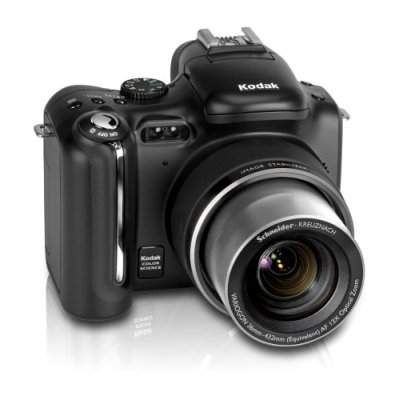The new Kodak EasyShare P712 replaces its predecessor, the P850 and as such takes top slot in Kodak’s "P" (for Pro) range. Like its predecessor, the new model comes packed with advanced features and plenty of control options for those who want to get hands-on in their photography.
Our quick take
With more than respectable image quality at lower ISOs, and three custom settings (almost essential to take the pain out of the many buttons and controls), the P712 can reward you with some excellent results. It is undeniably a well-specified camera but one that’s a bit of a mixed bag; what makes it good is offset by handling issues or the noisy sensor.
However, in the final analysis if you want a compact ultra-zoom camera that grows with you, or that provides plenty of scope for your snapping off the bat and your happy not making bigger prints, it’s worth a look.

Kodak EasyShare P712 digital camera - 4.0 / 5
| FOR | AGAINST |
|---|---|
|
|
The P712 is a compact, lightweight "bridge" camera, broadly SLR styled and offering the level of control usually afforded those larger models. Chief among the specification is surely the 12x optical zoom lens. The Schneider Kreuznach optics run from 36mm at the wide end to a remarkable 432mm at the longest zoom setting and offers the scope for almost any subject
The 7.1-megapixel CCD sat behind it provides enough resolution (on paper at least) for most print jobs up to and over A3, however the sensor’s small size (it’s a tiny, 1/2.5-inch type CCD) means those pixels are tightly packed and as we’ve seen so often, this crowding can lead to noise issues. More on which later.
Overall, handling is not bad but there is a problem. Most camera makers have to strike a balance between the physical size of the camera, the number of external controls and the amount of menu searching that might be needed to control a camera of any given complexity. That balance can be hard to achieve.
Kodak, when offered a fair amount of real estate on the P712 has opted to put plenty of external controls on the camera. Good! But they seem to have been pepper potted about all over the thing, landing hither and thither and without thought to their use. Here then, the balance has slipped away from the “too many menus” problem, now there seem to be to many external controls.
A “usual” mode dial provides fast access to the cameras manual controls (P, A, S and M) and automated controls such as the 18-subject program modes accessed from the "SCN" setting. You get three customisable settings too, where you can set the camera to three preferred control arrangements and is a great time saver given all those buttons.
The flash and focus control reside on the top left of the camera next to a too-easy-to-flare-in-bright-lighting electronic viewfinder, into which is built that flash unit. The drive mode, program mode and metering buttons sit the opposite side behind the combined shutter release and on/off/playback switch. On the back, another nine buttons join a four-way "joystick"-style controller, the lens zoom lever and a very nice to use, 2.5-inch colour screen.
Yes, this means you have fast access to the settings and controls offered up and the modes they control, but oh boy, it’s confusing to use meaning, on balance, a little less would be so much more here. Menus are however clear and easy to navigate using the little joystick. While the handling has its foibles, the camera offers a full suite of manual controls, making it a camera ideal for those wanting full control of their photography.
You can shoot JPEG, RAW and TIFF files; the addition of a RAW mode will certainly please the more advanced users this camera is aimed at. ISO sensitivity runs from clean and crisp (in terms of noise) ISO 64, 80, 100 and 125, through a less clean and crisp ISO 160 and then above ISO 200, that tiny pixel packed sensor starts to show its weakness.
You have ISO 250, 320, 400 and 800 but the noise is frankly unacceptable from ISO 250, particularly if you want those larger prints that this camera is capable of producing. Metering is good and the white balance (WB) control provides reasons to be cheerful, a great auto WB performance, and a great-to-use manual setting resulted in nicely neutral images that are easy to get. Add to this the fast AF set up (though strangely not so fast in macro and closer (non-macro) subjects) and the fast shutter response and things start to feel much better. However, close focusing in macro is limited to 10cm to 60cm (wide) and (gulp!) 90cm at the tele end. Not exactly “macro” then, but this limitation helps it perform better in general scenes.
In fact, the lens could have been the make or break for the P712, but the optics are excellent. Detail, particularly at the long zoom end where it packs in detail making the most of the camera’s resolution at lower ISOs. This combined with the image stabilisation, which gives around the equivalent of 2EV extra "handholdability" at longer focal lengths or in low light, claws back much needed points in the test.
Those images are saved either on 32MB of internal storage, which is only enough room for around six or seven "Fine" JPEGs, so will need to be joined by (a not supplied) SD/MMC external storage, which resides in a slot on the right side of the plastic body. A rechargeable lithium-ion battery pack slots neatly into a flip open port on the camera’s base and lasts well.
To recap
The Kodak EasyShare P712 provides plenty of scope for those trading up to a more advanced digital camera or for those who want that 12x ultra-zoom lens. Shame about the noise
